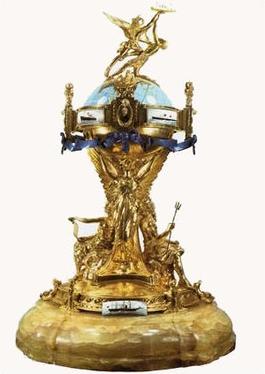
The Hales Trophy, officially the North Atlantic Blue Riband Challenge Trophy[1] is an award for the fastest Atlantic crossing by a commercial passenger vessel.
The award was created in 1935 when Harold K. Hales, a British politician and owner of Hales Brothers shipping company, donated the trophy[2] to be a permanent, tangible expression of the Blue Riband, the unofficial accolade then given for this feat. Hales also wished to formalize the rules regarding the contest, which up to then had no official form, though they were, by tradition, widely recognized. The rules for the Hales Trophy were different from the traditional rules for the Blue Riband, and changed several times. For example, the Hales Trophy was originally only awarded for westbound records.[3]
The trophy was awarded to just three Blue Riband holders during the express liner era; to the Italian liner Rex in 1935, the French Normandie in 1936, and the American United States in 1952. Cunard's Queen Mary, Blue Riband holder in 1936 and again from 1938 until 1952, did not receive the award for various reasons.
Following the retirement of United States in 1969 the award languished, until revived in 1990 for the Incat built passenger/car ferry Hoverspeed Great Britain when she established a new speed record for a commercial vessel on her eastbound delivery voyage without passengers that year.[4] The trophy has been won twice since then, each time by an Incat built vessel.
- ^ Kludas, Arnold (2000). Record breakers of the North Atlantic, Blue Riband Liners 1838–1952. London: Chatham. ISBN 1-86176-141-4.
- ^ Steve Birks (22 January 2008). "Hanley – Stoke-on-Trent Districts". The Potteries. Retrieved 10 July 2010.
- ^ Kludas p17
- ^ Barbara Lloyd (15 July 1990). "YACHTING: Suit May Be Filed Over Hales Trophy". The New York Times. Retrieved 10 July 2010.
